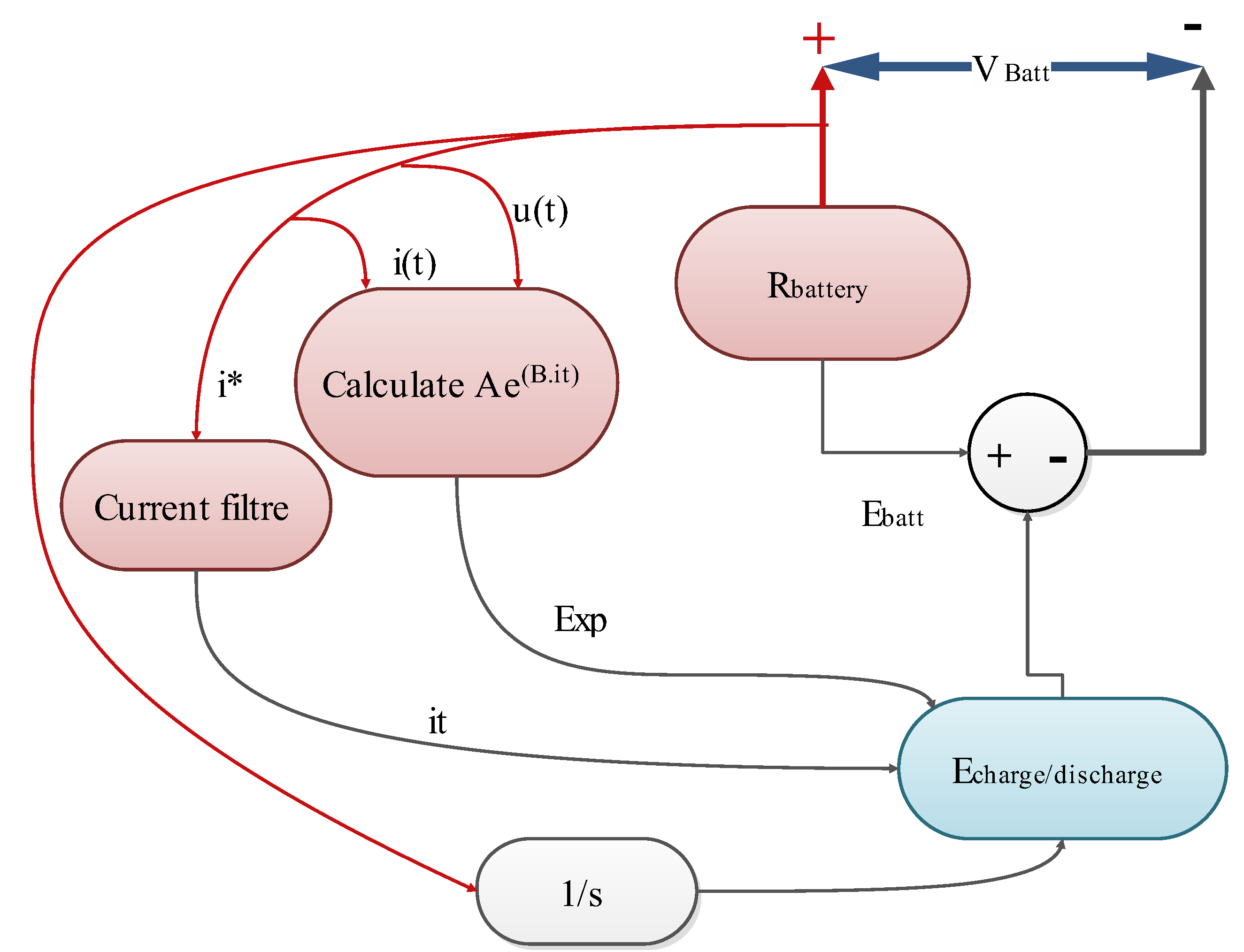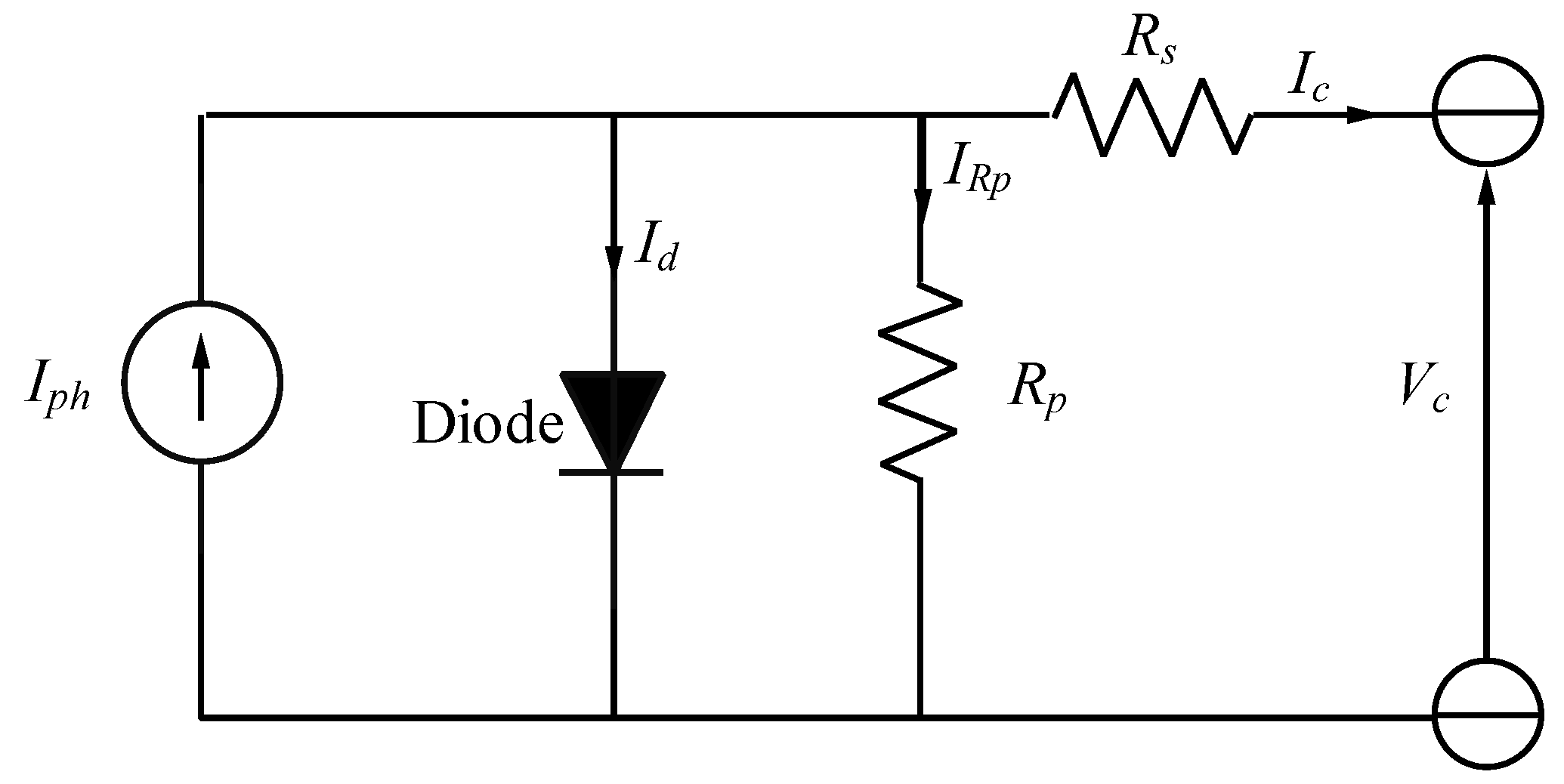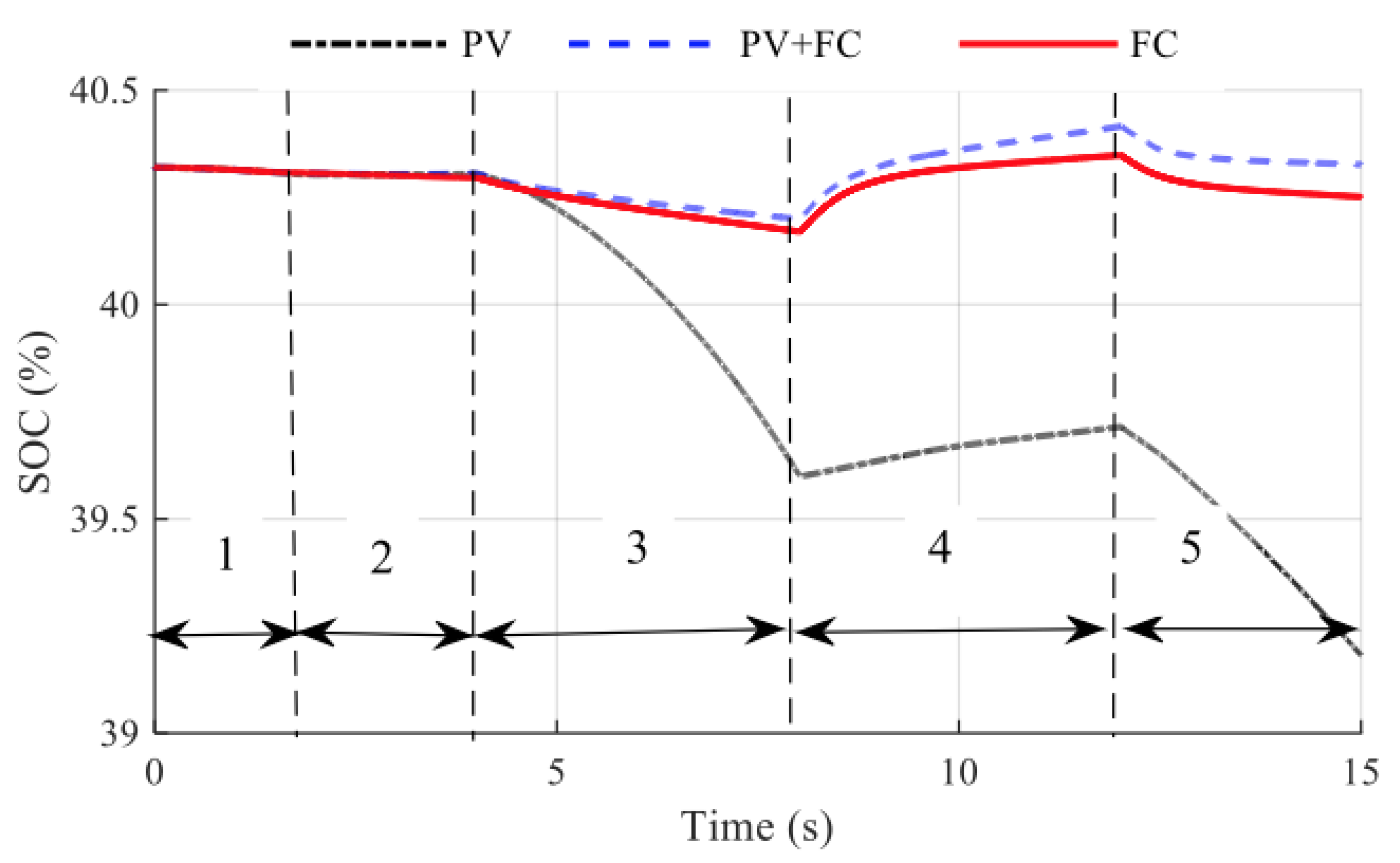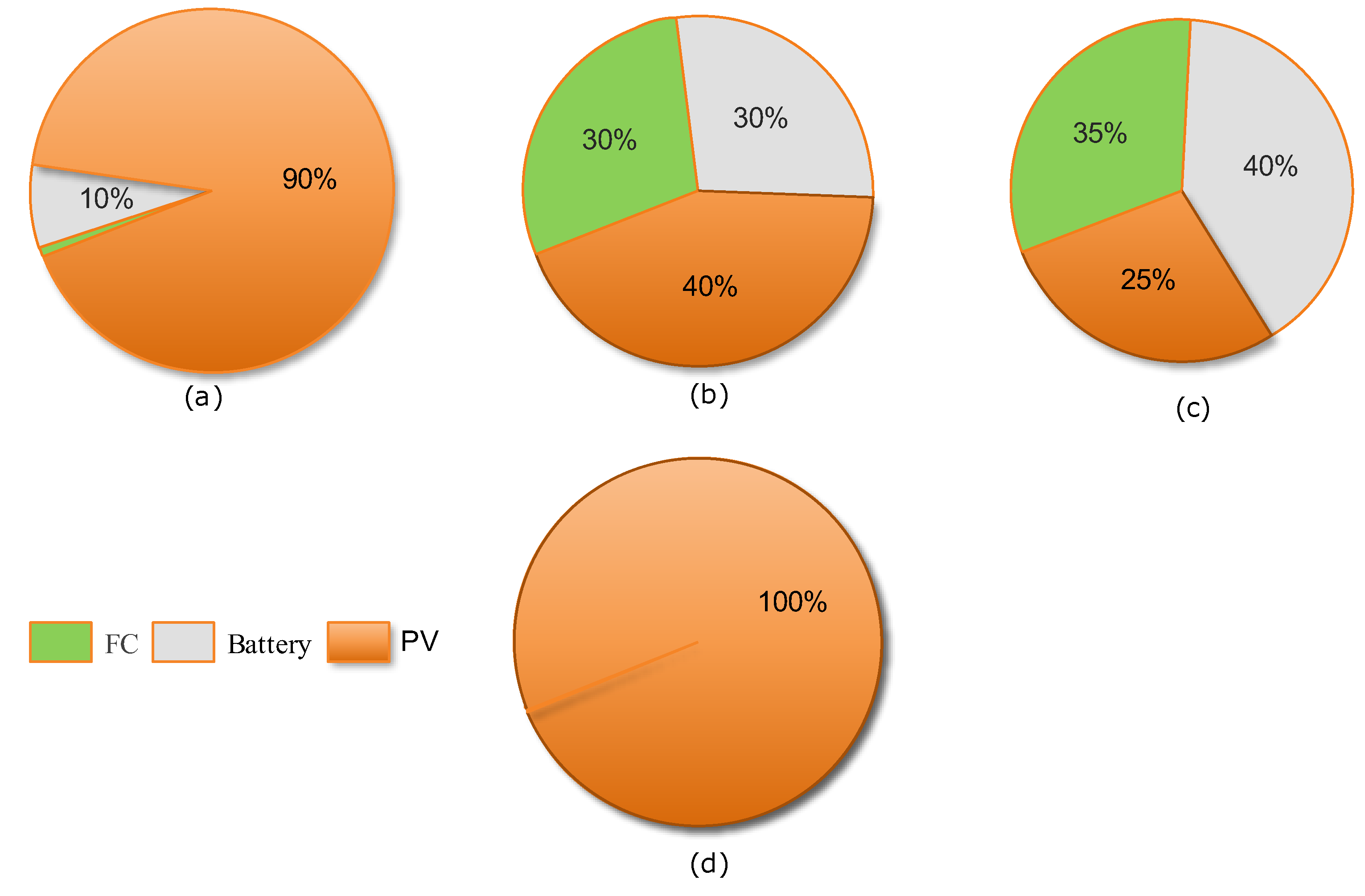Power Management and Control of a Hybrid Electric Vehicle Based on Photovoltaic, Fuel Cells, and Battery Energy Sources
Abstract
:1. Introduction
2. Electric Vehicle Description
2.1. General Review
2.2. The Associated Converters in the Electric Vehicle Model
3. The main Components of the Electric Vehicle
3.1. Lithium-Ion Battery Model
3.2. Electronic Equipment for The Recharging Solution
3.2.1. Bidirectional Converter
3.2.2. Converter Losses
MOSFET Losses
IGBT Losses
Diode Losses
Inductor Losses
Capacitor Losses
4. Modelling of the Hybrid Recharging Tool
4.1. The First Recharging Tool: The Photovoltaic Generator
4.2. The Second Recharging Tool: Fuel Cell Model
5. Results and Discussion
5.1. Simulation Conditions
5.2. Power Management and Control
5.3. Efficiency of a Hybrid System: Dynamic Mode and Static Mode
5.3.1. Case 1: Dynamic Mode
5.3.2. Case 2: Static Mode
5.4. Energetic Performance concerning Each Recharging Method
6. Conclusions
Author Contributions
Funding
Institutional Review Board Statement
Informed Consent Statement
Data Availability Statement
Acknowledgments
Conflicts of Interest
Abbreviations
| EV | Electric Vehicle |
| FC | Fuel Cell |
| IPT | Inductive Power Transfer |
| PV | Photovoltaic |
| HEV | Hybrid Electric Vehicles |
| BEV | Battery Electric Vehicles |
| ICE | Internal Combustion Engine |
| GV | Gasoline Vehicle |
| FCV | Fuel Cell Vehicle |
| SOC | State of Charge |
| List of symbols | |
| IGBT ON state (J) | |
| IGBT OFF state (J) | |
| MOSFET on state energy loss (J) | |
| MOSFET off-state energy loss (J) | |
| ESR | Effective series resistance (Ω) |
| Switching frequency (kHz) | |
| Collector current (A) | |
| Average collector current (A) | |
| Collector RMS current (A) | |
| Drain current (A) | |
| Drain RMS current (A) | |
| Inductor RMS current (A) | |
| Output current (A) | |
| Diode on-state voltage drop (V) | |
| Output DC voltage (V) | |
| Pcon, D | Diode conduction loss (W) |
| Pcon,M | MOSFET conduction loss (W) |
| Pcon,IGBT | IGBT conduction loss (W) |
| Psw,IGBT | IGBT switching loss (W) |
| Psw,M | MOSFET switching loss (W) |
| Qc | Schottky diode junction charge (C) |
| RC | Collector resistance (Ω) |
| Rdc | Inductor DC resistance (Ω) |
| RDS(on) | Drain to source on resistance (Ω) |
| Tsw | Switching period (s) |
| vCE | Instantaneous collector to emitter voltage (V) |
| vCEO | Collector voltage (V) |
| vDS | Instantaneous drain to source voltage (V) |
| VDS | Off condition of the drain to source voltage in (V) |
| T | Cell temperature in Kelvin (K) |
| q | Electron charge (1.602 × 10−19 C) |
| K | Boltzmann’s constant (1.381 × 10−23 J/K) |
| Irs | Saturation current of the diode |
| Pfuel | Pressure of fuel (atm) |
| Pair | Pressure of air (atm) |
| Vlpm(fuel) | Fuel flow rate (l min−1) |
| Vlpm(air) | Airflow rate (l min−1) |
| x | Hydrogen in the fuel (%) |
| y | Oxygen in the oxidant (%) |
| N | Cell number |
| z | Moving electrons |
| Kc | Voltage of nominal operation conditions (V) |
| k | Boltzmann’s constant [J K−1] |
| h | Planck constant [J s] |
| Nominal efficiency (%) | |
| Enthalpy of water vapour (J mol−1) | |
| Nominal voltage (V) | |
| Inom | Nominal current (A) |
| ifc | FC current (A) |
| Nominal airflow rate (l min−1) | |
| A | Exponential zone amplitude (V) |
| Pairnom | Nominal absolute pressure of air (Pa) |
| Q | Battery capacity (Ah) |
| Tnom | Nominal operating temperature (K) |
| I* | Current of low-frequency dynamic (A) |
| PH2O | Water pressure (bar) |
| it | Available capacity (Ah) |
| Percentage in the oxidant (%) | |
| K | Polarisation constant or polarisation resistance (Ω) |
| B | Exponential zone time constant inverse (Ah)−1 |
| E0 | Standard voltage (V) |
| Ebatt | Nonlinear voltage (V) |
References
- Alam Chowdhury, M.S.; Rahman, A.M.; Samrat, N.H. A comprehensive study on green technologies used in the vehicle. In Proceedings of the 2015 3rd International Conference on Green Energy and Technology (ICGET), Dhaka, Bangladesh, 11 September 2015. [Google Scholar]
- Ahmad, S.; Ahmad, A.; Naeem, M.; Ejaz, W.; Kim, H.S. A compendium of performance metrics, pricing schemes, optimisation objectives, and solution methodologies of demand side management for the smart grid. Energies 2018, 11, 2801. [Google Scholar] [CrossRef] [Green Version]
- Thomas, C.E. Fuel cell and battery electric vehicles compared. Int. J. Hydrogen Energy 2009, 34, 6005–6020. [Google Scholar] [CrossRef] [Green Version]
- Hwang, J.J.; Wang, D.Y.; Shih, N.C. Development of a lightweight fuel cell vehicle. J. Power Sources 2005, 141, 108–115. [Google Scholar] [CrossRef]
- Veziroglu, A.; MacArio, R. Fuel cell vehicles: State of the art with economic and environmental concerns. Int. J. Hydrogen Energy 2011, 36, 25–43. [Google Scholar] [CrossRef]
- Mohamed, N.; Aymen, F.; Ali, Z.M.; Zobaa, A.F.; Aleem, S.H.E.A. Efficient Power Management Strategy of Electric Vehicles Based Hybrid Renewable Energy. Sustainability 2021, 13, 7351. [Google Scholar] [CrossRef]
- Zhang, R.; Tao, J.; Zhou, H. Fuzzy Optimal Energy Management for Fuel Cell and Supercapacitor Systems Using Neural Network Based Driving Pattern Recognition. IEEE Trans. Fuzzy Syst. 2019, 27, 45–57. [Google Scholar] [CrossRef] [Green Version]
- Moore, R.M.; Hauer, K.H.; Friedman, D.; Cunningham, J.; Badrinarayanan, P.; Ramaswamy, S.; Eggert, A. A dynamic simulation tool for hydrogen fuel cell vehicles. J. Power Sources 2005, 141, 272–285. [Google Scholar] [CrossRef]
- Mokrani, Z.; Rekioua, D.; Rekioua, T. Modeling, control and power management of hybrid photovoltaic fuel cells with battery bank supplying electric vehicle. Int. J. Hydrogen Energy 2014, 39, 15178–15187. [Google Scholar] [CrossRef]
- Hwang, J.J.; Chen, Y.J.; Kuo, J.K. The study on the power management system in a fuel cell hybrid vehicle. Int. J. Hydrogen Energy 2012, 37, 4476–4489. [Google Scholar] [CrossRef]
- Wang, M. Fuel choices for fuel-cell vehicles: Well-to-wheels energy and emission impacts. J. Power Sources 2002, 112, 307–321. [Google Scholar] [CrossRef]
- Hwang, J.J.; Kuo, J.K.; Wu, W.; Chang, W.R.; Lin, C.H.; Wang, S.E. Lifecycle performance assessment of fuel cell/battery electric vehicles. Int. J. Hydrogen Energy 2013, 38, 3433–3446. [Google Scholar] [CrossRef]
- Un-Noor, F.; Padmanaban, S.; Mihet-Popa, L.; Mollah, M.N.; Hossain, E. A comprehensive study of key electric vehicle (EV) components, technologies, challenges, impacts, and future direction of development. Energies 2017, 10, 1217. [Google Scholar] [CrossRef] [Green Version]
- Boretti, A. Analysis of the energy storage battery and fuel tank of a commercial electric vehicle with range extender during charge sustaining operation. Energy Storage 2020, 2, e129. [Google Scholar] [CrossRef]
- Baek, K.; Kim, S.; Lee, E.; Cho, Y.; Kim, J. Data-Driven Evaluation for Demand Flexibility of Segmented Electric Vehicle Chargers in the Korean Residential Sector. Energies 2021, 14, 866. [Google Scholar] [CrossRef]
- Ahmad, S.; Alhaisoni, M.M.; Naeem, M.; Ahmad, A.; Altaf, M. Joint Energy Management and Energy Trading in Residential Microgrid System. IEEE Access 2020, 8, 123334–123346. [Google Scholar] [CrossRef]
- Lulhe, A.M.; Date, T.N. A technology review paper for drives used in electrical vehicle (EV) & hybrid electrical vehicles (HEV). In Proceedings of the 2015 International Conference on Control, Instrumentation, Communication and Computational Technologies ICCICCT, Kumaracoil, India, 18–19 December 2015; pp. 632–636. [Google Scholar]
- Mohamed, N.; Aymen, F.; Alqarni, M. Inductive Power Transmission System for Electric Car Charging Phase: Modeling plus Frequency Analysis. World Electr. Veh. J. 2021, 12, 267. [Google Scholar] [CrossRef]
- Datta, U. A price-regulated electric vehicle charge-discharge strategy. Energy Res. 2019, 43, 1032–1042. [Google Scholar] [CrossRef] [Green Version]
- Rawat, T.; Niazi, K.R.; Gupta, N.; Sharma, S. Impact assessment of electric vehicle charging/discharging strategies on the operation management of grid accessible and remote microgrids. Int. J. Energy Res. 2019, 43, 9034–9048. [Google Scholar] [CrossRef]
- Models, T.; Kim, Y.; Kim, S. Forecasting Charging Demand of Electric Vehicles Using Time-Series Models. Energies 2021, 14, 1487. [Google Scholar]
- Mohamed, N.; Aymen, F.; Issam, Z.; Bajaj, M.; Ghoneim, S.S.M. The Impact of Coil Position and Number on Wireless System Performance for Electric Vehicle Recharging. Sensors 2021, 21, 4343. [Google Scholar] [CrossRef]
- Song, Z.; Hofmann, H.; Li, J.; Wang, Y.; Lu, D.; Ouyang, M.; Du, J. Torque Distribution Strategy for Multi-PMSM Applications and Optimal Acceleration Control for Four-Wheel-Drive Electric Vehicles. J. Dyn. Syst. Meas. Control 2019, 142, 021001. [Google Scholar] [CrossRef]
- Habib, S.; Khan, M.M.; Abbas, F.; Ali, A.; Faiz, M.T.; Ehsan, F.; Tang, H. Contemporary trends in power electronics converters for charging solutions of electric vehicles. CSEE J. Power Energy Syst. 2020, 6, 911–929. [Google Scholar]
- Tie, S.S.F.; Tan, C.W.C. A review of energy sources and energy management system in electric vehicles. Renew. Sustain. Energy Rev. 2013, 20, 82–102. [Google Scholar] [CrossRef]
- Tan, K.M.; Ramachandaramurthy, V.K.; Yong, J.Y. Integration of electric vehicles in smart grid: A review on vehicle to grid technologies and optimisation techniques. Renew. Sustain. Energy Rev. 2016, 53, 720–732. [Google Scholar] [CrossRef]
- Lipu, M.S.H.; Faisal, M.; Ansari, S.; Hannan, M.A.; Karim, T.F.; Ayob, A.; Hussain, A.; Miah, M.S.; Saad, M.H.M. Review of Electric Vehicle Converter Configurations, Control Schemes and Optimizations: Challenges and Suggestions. Electronics 2021, 10, 477. [Google Scholar] [CrossRef]
- Naoui, M.; Aymen, F.; Ben Hamed, M.; Lassaad, S. Analysis of Battery-EV state of charge for a Dynamic Wireless Charging system. Energy Storage 2019, 2, e117. [Google Scholar]
- Zhuang, Z.; Yang, L.; Ju, B.; Yin, A.; Lei, G.; Zhou, Q.; Tang, Y.; Deng, Z.; Tu, F.; Qin, S. Engineering LiNi0.5Co0.2Mn0.3O2/poly(propylene carbonate) interface by graphene oxide modification for all-solid-state lithium batteries. Energy Storage 2020, 2, e109. [Google Scholar] [CrossRef] [Green Version]
- Lee, J.Y.; Han, B.M. A bidirectional wireless power transfer EV charger using self-resonant PWM. IEEE Trans. Power Electron. 2015, 30, 1784–1787. [Google Scholar] [CrossRef]
- Tremblay, O.; Dessaint, L. Experimental Validation of a Battery Dynamic Model for EV Applications. World Electr. Veh. J. 2009, 3, 289–298. [Google Scholar] [CrossRef] [Green Version]
- Dubarry, M.; Vuillaume, N.; Liaw, B.Y. From single cell model to battery pack simulation for Li-ion batteries. J. Power Sources 2009, 186, 500–507. [Google Scholar] [CrossRef]
- Rothenberger, M.J.; Safi, J.; Liu, J.; Anstrom, J.; Brennan, S.; Fathy, H.K. Improving Lithium-Ion Battery Pack Diagnostics by Optimising the Internal Allocation of Demand Current for Parameter Identifiability. J. Dyn. Syst. Meas. Control 2017, 139, 081001. [Google Scholar] [CrossRef]
- Mohamed, N.; Aymen, F.; Lassaad, S.; Mouna, B.H. Practical validation of the vehicle speed influence on the wireless recharge system efficiency. In Proceedings of the 2020 6th IEEE International Energy Conference (ENERGYCon), Gammarth, Tunisia, 28 September–1 October 2020; pp. 372–376. [Google Scholar]
- Dhameja, S. Electric Vehicle Battery Charging. In Electric Vehicle Battery Systems; Butterworth–Heinemann: Woburn, MA, USA, 2001; pp. 69–91. [Google Scholar]
- Baliga, B.J. Power Semiconductor Device Figure of Merit for High-Frequency Applications. IEEE Electron Device Lett. 1989, 10, 455–457. [Google Scholar] [CrossRef]
- Elasser, A.; Chow, T.P. Silicon carbide benefits and advantages for power electronics circuits and systems. Proc. IEEE 2002, 90, 969–986. [Google Scholar] [CrossRef]
- Hudgins, J.L.; Simin, G.S.; Santi, E.; Khan, M.A. An assessment of wide band-gap semiconductors for power devices. IEEE Trans. Power Electron. 2003, 18, 907–914. [Google Scholar] [CrossRef] [Green Version]
- El Fadil, H.; Giri, F.; Member, S.; Guerrero, J.M.; Member, S. Modeling and Nonlinear Control of a Fuel Cell/Supercapacitor Hybrid Energy Storage System for Electric Vehicles. IEEE Trans. Veh. Technol. 2014, 63, 3011–3018. [Google Scholar] [CrossRef] [Green Version]
- Alam, M.; Kumar, K.; Dutta, V. Comparative efficiency analysis for silicon, silicon carbide MOSFETs and IGBT device for DC–DC boost converter. SN Appl. Sci. 2019, 1, 1–11. [Google Scholar] [CrossRef] [Green Version]
- Mohamed, N.; Aymen, F.; Hamed, M. Ben Characteristic Of Photovoltaic Generator For The Electric Vehicle. Int. J. Sci. Technol. Res. 2019, 8, 871–876. [Google Scholar]
- Ahmed, M.; Abdelrahem, M.; Harbi, I.; Kennel, R. An Adaptive Model-Based MPPT Technique with Drift-Avoidance for Grid-Connected PV Systems. Energies 2020, 13, 6656. [Google Scholar] [CrossRef]
- Bendjedia, B.; Hadjadj, A.; Benhouia, A.; Temmir, T. Energy management and control of a solar electric vehicle. In Proceedings of the 2015 4th International Conference on Electrical Engineering (ICEE), Boumerdes, Algeria, 13–15 December 2015; pp. 1–5. [Google Scholar] [CrossRef]
- Ye, B.; Jiang, J.; Miao, L.; Yang, P.; Li, J.; Shen, B.; Ye, B.; Jiang, J.; Miao, L.; Yang, P.; et al. Feasibility Study of a Solar-Powered Electric Vehicle Charging Station Model. Energies 2015, 8, 13265–13283. [Google Scholar] [CrossRef] [Green Version]
- Paladini, V.; Donateo, T.; de Risi, A.; Laforgia, D. Super-capacitors fuel-cell hybrid electric vehicle optimisation and control strategy development. Energy Convers. Manag. 2007, 48, 3001–3008. [Google Scholar] [CrossRef]
- Cipollone, R.; Di Battista, D.; Marchionni, M.; Villante, C. Model based design and optimisation of a fuel cell electric vehicle. Energy Procedia 2014, 45, 71–80. [Google Scholar] [CrossRef] [Green Version]
- Hwang, J.J.; Chen, C.K.; Savinell, R.F.; Liu, C.C.; Wainright, J. A three-dimensional numerical simulation of the transport phenomena in the cathodic side of a PEMFC. J. Appl. Electrochem. 2004, 34, 217–224. [Google Scholar] [CrossRef]
- Andaloro, L.; Arista, A.; Agnello, G.; Napoli, G.; Sergi, F.; Antonucci, V. Study and design of a hybrid electric vehicle (Lithium Batteries-PEM FC). Int. J. Hydrogen Energy 2017, 42, 3166–3184. [Google Scholar] [CrossRef]
- Schouten, N.J.; Salman, M.A.; Kheir, N.A. Fuzzy logic control for parallel hybrid vehicles. IEEE Trans. Control Syst. Technol. 2002, 10, 460–468. [Google Scholar] [CrossRef]
- Fu, Z.; Zhu, L.; Tao, F.; Si, P.; Sun, L. Optimization based energy management strategy for fuel cell/battery/ultracapacitor hybrid vehicle considering fuel economy and fuel cell lifespan. Int. J. Hydrogen Energy 2020, 45, 8875–8886. [Google Scholar] [CrossRef]
- Hoenicke, P.; Ghosh, D.; Muhandes, A.; Bhattacharya, S.; Bauer, C.; Kallo, J.; Willich, C. Power management control and delivery module for a hybrid electric aircraft using fuel cell and battery. Energy Convers. Manag. 2021, 244, 114445. [Google Scholar] [CrossRef]
- Tran, D.D.; Vafaeipour, M.; El Baghdadi, M.; Barrero, R.; Van Mierlo, J.; Hegazy, O. Thorough state-of-the-art analysis of electric and hybrid vehicle powertrains: Topologies and integrated energy management strategies. Renew. Sustain. Energy Rev. 2020, 119, 109596. [Google Scholar] [CrossRef]
- Ahmad, S.; Naeem, M.; Ahmad, A. Unified optimisation model for energy management in sustainable smart power systems. Int. Trans. Electr. Energy Syst. 2020, 30, e12144. [Google Scholar] [CrossRef]
- Nguyen, B.H.; Trovão, J.P.F.; German, R.; Bouscayrol, A. Real-time energy management of parallel hybrid electric vehicles using linear quadratic regulation. Energies 2020, 13, 5538. [Google Scholar] [CrossRef]
- Zhang, Y.; Ma, R.; Zhao, D.; Huangfu, Y.; Liu, W. A Novel Energy Management Strategy based on Dual Reward Function Q-learning for Fuel Cell Hybrid Electric Vehicle. IEEE Trans. Ind. Electron. 2021, 69, 1537–1547. [Google Scholar] [CrossRef]
- Oberbeck, L.; Alvino, K.; Goraya, B.; Jubault, M. IPVF’s PV technology vision for 2030. Prog. Photovolt. Res. Appl. 2020, 28, 1207–1214. [Google Scholar] [CrossRef]
- Sierra, A.; Reinders, A. Designing innovative solutions for solar-powered electric mobility applications. Prog. Photovolt. Res. Appl. 2020, 29, 802–818. [Google Scholar] [CrossRef]
- Das, H.S.; Rahman, M.M.; Li, S.; Tan, C.W. Electric vehicles standards, charging infrastructure, and impact on grid integration: A technological review. Renew. Sustain. Energy Rev. 2020, 120, 109618. [Google Scholar] [CrossRef]
- Turoń, K. Hydrogen-powered vehicles in urban transport systems-current state and development. Transp. Res. Procedia 2020, 45, 835–841. [Google Scholar] [CrossRef]
- Okundamiya, M.S. Size optimisation of a hybrid photovoltaic/fuel cell grid connected power system including hydrogen storage. Int. J. Hydrogen Energy 2021, 46, 30539–30546. [Google Scholar] [CrossRef]













| Si | 4H-SiC | 6H-SiC | GaAs | GaN | Diamond | |
|---|---|---|---|---|---|---|
| Energy band-gap, Eg (eV) | 1.12 | 3.03 | 3.26 | 1.43 | 3.45 | 5.45 |
| Critical electric field, Ec (MV/cm) | 0.25 | 2.2 | 2.5 | 0.4 | 2 | 10 |
| Saturated electron drift velocity, Vsat (cm/s) | 1 × 107 | 2 × 107 | 2 × 107 | 1 × 107 | 2.2 × 107 | 2.7 × 107 |
| Thermal conductivity I (W/cm-K) | 1.5 | 4.9 | 4.9 | 0.46 | 1.3 | 22 |
| Electron mobility, µn (cm2/s) | 1350 | 1000 | 500 | 8500 | 1250 | 2200 |
| Dielectric constant, et | 11.9 | 10.1 | 9.66 | 13.1 | 9 | 5.5 |
| Parameters | Symbol | Values |
|---|---|---|
| Vehicle mass | m | 1800 kg |
| Rolling resistance | fr | 0.01 |
| Air density | 1.2 kg × m2 | |
| The frontal surface area of the EV | Af | 2.6 m2 |
| Tire radius | R | 0.32 m |
| Aerodynamic drag coefficient | Cd | 0.41 |
| Parameters | Symbol | Values |
|---|---|---|
| Shaft power | Pu | 50 kW |
| Pole pairs | Pp | 2 |
| Resistance of stator | Rs | 2.63 Ω |
| Resistance of rotor | Rr | 2.42 Ω |
| Mutual inductance | M | 0.253 H |
| Rotor and stator self-inductance | Ls = Lr | 0.214 H |
| Inertia moment | J | 0.03 kg m2 |
| Viscous friction | f | 0.0002 N m × s2 |
| Battery parameters | ||
| Battery voltage | 72 V | |
| Rated Capacity | 68 Ah | |
| Rated Power | 50 kW | |
| Type | Lithium battery | - |
| Energy Gain | |||
|---|---|---|---|
| PV | FC | PV + FC | |
| At the beginning of the zone | 39.6% | 40.17% | 40.2% |
| At the end of the zone | 39.71% | 40.35% | 40.42% |
| SOC gain | 0.11% | 0.18% | 0.22% |
| With the Weight of PV | Without the Weight of PV | |
|---|---|---|
| Example of vehicle model weight | 750 kg | 737 kg |
| Energy consumed over 100 km | 14.08 kWh | 14 kWh |
Publisher’s Note: MDPI stays neutral with regard to jurisdictional claims in published maps and institutional affiliations. |
© 2022 by the authors. Licensee MDPI, Basel, Switzerland. This article is an open access article distributed under the terms and conditions of the Creative Commons Attribution (CC BY) license (https://creativecommons.org/licenses/by/4.0/).
Share and Cite
Mohamed, N.; Aymen, F.; Altamimi, A.; Khan, Z.A.; Lassaad, S. Power Management and Control of a Hybrid Electric Vehicle Based on Photovoltaic, Fuel Cells, and Battery Energy Sources. Sustainability 2022, 14, 2551. https://doi.org/10.3390/su14052551
Mohamed N, Aymen F, Altamimi A, Khan ZA, Lassaad S. Power Management and Control of a Hybrid Electric Vehicle Based on Photovoltaic, Fuel Cells, and Battery Energy Sources. Sustainability. 2022; 14(5):2551. https://doi.org/10.3390/su14052551
Chicago/Turabian StyleMohamed, Naoui, Flah Aymen, Abdullah Altamimi, Zafar A. Khan, and Sbita Lassaad. 2022. "Power Management and Control of a Hybrid Electric Vehicle Based on Photovoltaic, Fuel Cells, and Battery Energy Sources" Sustainability 14, no. 5: 2551. https://doi.org/10.3390/su14052551
APA StyleMohamed, N., Aymen, F., Altamimi, A., Khan, Z. A., & Lassaad, S. (2022). Power Management and Control of a Hybrid Electric Vehicle Based on Photovoltaic, Fuel Cells, and Battery Energy Sources. Sustainability, 14(5), 2551. https://doi.org/10.3390/su14052551










